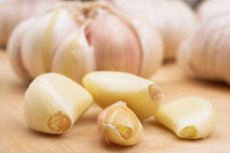New publications
Garlic is effective in lowering blood sugar and cholesterol levels
Last reviewed: 02.07.2025

All iLive content is medically reviewed or fact checked to ensure as much factual accuracy as possible.
We have strict sourcing guidelines and only link to reputable media sites, academic research institutions and, whenever possible, medically peer reviewed studies. Note that the numbers in parentheses ([1], [2], etc.) are clickable links to these studies.
If you feel that any of our content is inaccurate, out-of-date, or otherwise questionable, please select it and press Ctrl + Enter.

In a recently published study in the journal Nutrients, a team of Chinese scientists conducted a systematic review and meta-analysis to examine the effects of garlic on blood lipid and glucose levels in humans.
Chronic noncommunicable diseases, including cardiovascular diseases, chronic respiratory diseases, cancer and diabetes, cause 41 million deaths annually. Glucose and lipids are important for energy production, and their imbalance can lead to atherosclerosis, diabetes and fatty liver disease. Dyslipidemia, characterized by high total cholesterol (TC), low-density lipoprotein (LDL), triglycerides (TG) and low high-density lipoprotein (HDL), is a major risk factor for cardiovascular disease. Current treatments for metabolic diseases focus on symptomatic relief and have side effects. Garlic, rich in compounds such as allicin, shows potential in regulating glucose and lipid levels. Further research is needed to understand its mechanisms of action, optimal dosage and long-term effects.
The study involved 1,567 participants from various countries including Canada, the United States, Korea, Iran, Pakistan, India, Israel, Russia, Poland, Brazil, and Denmark. The participants ranged in age from 18 to 80 years, and the garlic use period ranged from 3 weeks to 1 year. The participants had various health conditions such as hyperlipidemia, type 2 diabetes, coronary heart disease, non-alcoholic fatty liver disease, myocardial infarction, obesity, hypertension, polycystic ovary syndrome, and some were healthy adults. Most of the participants were not receiving medication during the study, while some continued to take their daily medications. Garlic preparations included powder, raw garlic, oil, aged extract, and enteric-coated tablets in various daily doses.
A meta-analysis assessed the effects of garlic on glucose metabolism parameters. Eight studies with 12 effects showed a significant reduction in fasting blood glucose (FBG) due to garlic consumption. Three trials with seven effects showed a significant effect on HbA1c levels. An analysis of 17 studies with 19 effects showed a significant reduction in total cholesterol (TC) levels, while 19 studies with 22 effects showed a positive effect on HDL levels. For LDL, data from 18 randomized controlled trials with 21 effects indicated a significant reduction due to garlic consumption.
In conclusion, garlic significantly improved FBG, HbA1c, TC, LDL, and HDL levels, but had no effect on TG levels. The study used a random effects model due to high heterogeneity, with garlic supplementation periods ranging from 3 weeks to 1 year. Different forms of garlic, such as raw garlic, aged garlic extract, and garlic powder tablets, were effective. Despite some publication bias and variations in interventions, the beneficial effects of garlic on blood glucose and lipid profiles were evident.
